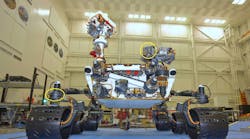The Curiosity rover features the largest, most advanced scientific payload of any Mars mission yet — and thin- section bearings.
The five pairs of duplexed bearings from Kaydon Bearings Division save space and weight in two important areas: preparing rock material samples for analysis and supporting the steering actuators for the rover’s wheels.
The one-ton Curiosity, about the size of a small SUV, will analyze samples drilled from rocks or scooped from the ground to assess whether the environment near its landing site might once have been able to support life. The rover was designed, developed and assembled by the Jet Propulsion Laboratory (JPL), a division of the California Institute of Technology, for NASA’s Science Mission Directorate.
One pair of duplexed Reali-Slim bearings is in the CHIMRA (Collection and Handling for In-Situ Rock Analysis), one of a number of devices mounted on a turret at the end of the rover’s robotic arm. These angular contact bearings with a 3-inch O.D. are a key part of the thwack mechanism that must keep the primary sieve from clogging so that samples can reach the analytical instruments. The screens in the sieves have tiny holes — 150-micron and 1mm — to produce particles of the appropriate size; i.e. like a crushed aspirin. JPL engineers decided early on that thin section bearings were the best way to handle the load in the small space available, and built the design around them.
The other four sets of Kaydon bearings (7-inch O.D., 6-inch bore) support the steering actuators on Curiosity’s four corners and relieve some of the load on them, which was critical during the landing. These bearings, like those in the CHIMRA, are angular contact in duplex pairs, with races and balls of 440C stainless steel and a built-in preload. JPL requested that all be shipped dry, including the phenolic separators, so they could add a space-rated lubricant that would not turn viscous in the extreme cold or evaporate in the thin atmosphere.
With a typical speed of about one inch per second, this latest rover is expected to cover about 660 feet of Martian terrain per day when it begins collecting samples in September. For the next 23 months it will send data, images and a variety of scientific observations back to Earth, where scientists hope the $2.5 billion mission will shed light on the question of whether there is — or has ever been — life on Mars. For more information, visit Kaydon's bearings page.

Sponsored Recommendations
Sponsored Recommendations
KNF Pumps Revolutionize Desert Dust Tracking
April 3, 2024
NEW Low Profile, Ultra Compact Power Supplies
March 13, 2024
Voice your opinion!
Voice your opinion!
